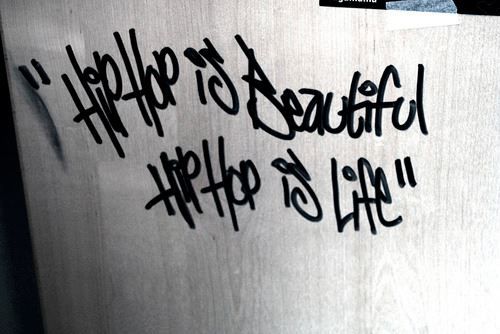I love hip-hop! Growing up in Los Angeles in the 1980s and 90s hip-hop was the norm– the culture. Even if you weren’t a B-Boy (beat boy) or B-Girl there were elements of hip-hop youth incorporated into our being. My brother wore squeaky-clean tennis shoes with ironed jeans and ironed t-shirts. For me, hip-hop confirmed my suspicions that something wasn’t right in the world. It also reflected my reality back to me with places, sayings, sights and sounds that I could relate. It affirmed who I was as a brown person in a white-dominated society.
There’s divinity within because we come from the divine,
A force that’s not seen, but you feel it every time:
When the wind blows, and the world turns,
And the rain drops, and the baby cries,
And the bird flies, and the ground quake,
And the stars gleam.
– Q-Tip, “The Remedy,” from Get on the Bus Soundtrack, 1996
I was listening to rap by Q-Tip, Queen Latifa, Heavy D., Salt-N-Pepa, Public Enemy, Wu-Tang Clan, LL Cool J, Mos Def, Run DMC, and of course 2Pac and Snoop Dogg. Hip-hop was a counterculture movement that gave voice to youth who felt powerless against the system, who wanted to expose the system for what it was- historically and currently oppressive to black and brown peoples. Hip-hop was expression, freedom, it was speaking up and bringing attention to our condition but also cathartic, it was a way to keep from going insane. This was also the War on Drugs era when everybody in the ‘hood had a family member, or two, or three, addicted to crack. The police were the enemy. There were drive-bys and “jackings” (being robbed up close and personal) happening every day in South Central. So hip-hop was our sanctuary, our way to “speak truth to power” (Bautista, Bertrand, Morrell, Scorza & Matthews, 2013, p. 4).
Speaking truth to and about systems of power is what youth participatory action research (YPAR) is about (Bautista et al., 2013). It is a research methodology that puts youth at the center of their own lives through research they conduct about their experiences. As Bautista and his colleagues describe, “…YPAR is many things: a pedagogical practice, a form of resistance, a revising of whose knowledge is valuable, a tool of decolonization, and a radical research methodology” (Bautista et al., 2013, p. 5). Like rap, “…youth in YPAR develop their cultural consciousness” (Bautista et al., 2013, p. 6). Unlike rap, YPAR teaches youth tools to conduct multi-modal research about their communities so that they are armed with data to challenge systems of inequity.
I was able to find a presentation on my Los Angeles high school conducted by a California Council of Youth research group. The research about my high school, Manual Arts, indicated overcrowding, lack of or poor quality educational supplies, unavailability of counselors and teachers for guidance and poor preparation for college. Students identified three demands: money must be invested into course and school supplies, easy access to school counselors, and increased after-school and extracurricular activities (Armstrong, et al., 2010). Change takes time, but it is through youth participatory action research that educational equity can be achieved with the input of all stakeholders.
References
Armstrong, A., Dominguez, G., Herrera, J., McCoy, M., Torres, R. & McClain, R. (2010). They have learned to live it down as though they did not care [Powerpoint slides]. Retrieved from http://idea.gseis.ucla.edu/projects/the-council-of-youth-research/projects-presentations/2010-powerpoint
Bautista, M.A., Bertrand, M., Morrell, E., D’Artangnan, S. & Matthews, C. (2013). Participatory Action Research and City Youth: Methodological Insights from the Council of Youth Research. Teachers College Record, 115(100303), 1-23
Mona Scott
Latest posts by Mona Scott (see all)
- Be Still My Warrior Heart! A Revitalizing Indigenous Education Pedagogy Rooted in Sovereignty – June 20, 2014
- Objectivity and the White Racial Frame Subdued? – June 17, 2014
- Don’t Believe the Hype: Indigenous Student Learning Styles May Not Conform to the Literature – June 14, 2014
- Fight the Power: De-centering white supremacy in scholarship and research – June 10, 2014
- Indigenous Students Identify Six Factors That Impact Degree Completion – June 6, 2014
